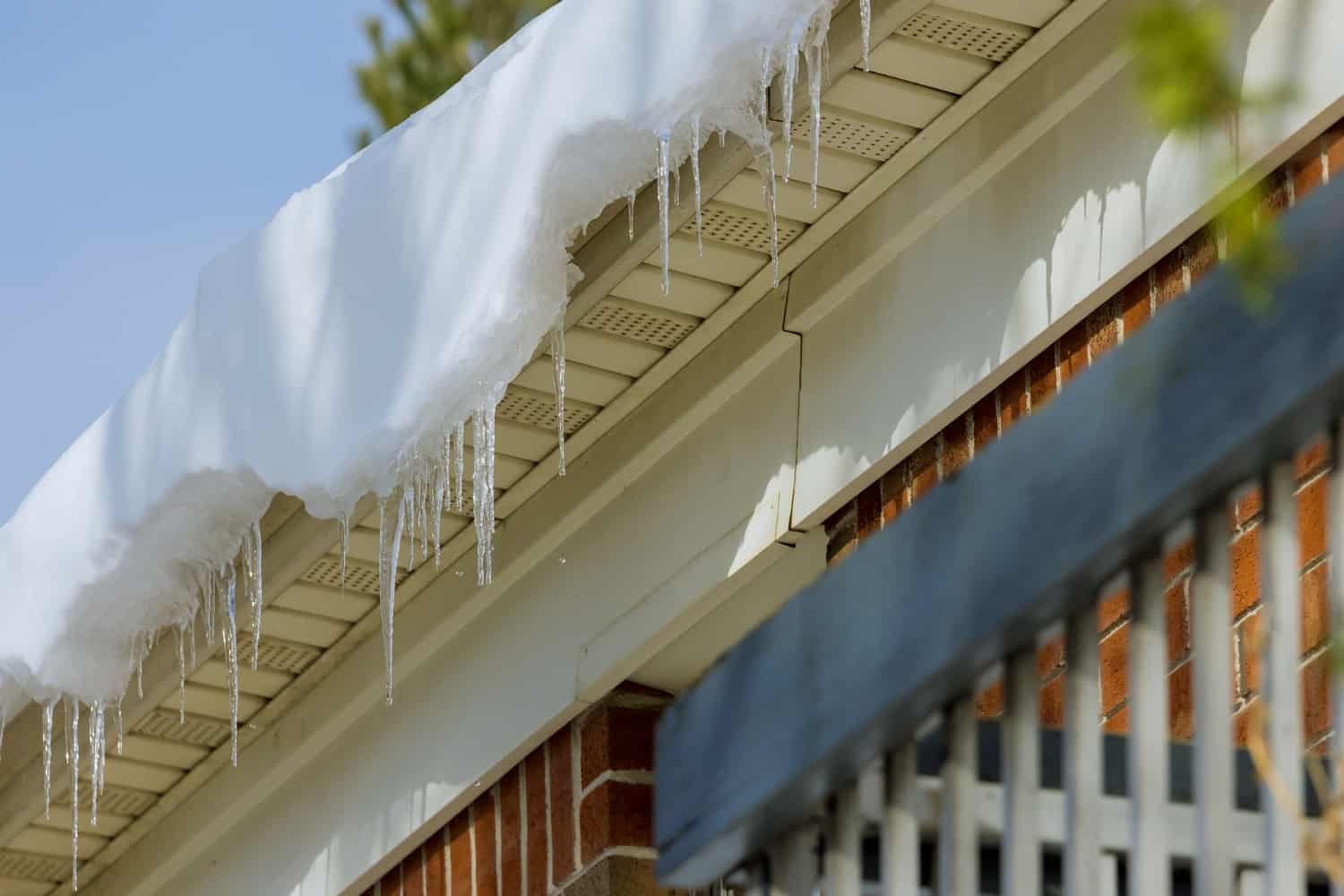How to Remove Ice from Gutters: What to Know Before You Get on the Ladder
So, you’re wondering how to remove ice from your gutters in the middle of winter. Chances are you’re ready to drag out the ladder, climb up in the frigid weather, and do your best to chip away or pour hot water in your gutters.
Before you get out the ladder for a dangerous job, it may be time to assess your icy situation a little more closely.

Why Ice Dams Happen
Icicles are beautiful, but they can also cause a lot of damage to your gutters and roof in the winter. More importantly, if there are areas of your home where the icicles have built up, it’s a sign that you may already have ice damage happening.
We have some funny winter traditions in the upper Midwest to prepare our homes for cold weather. We get out tape and plastic to cover the windows. We look up how to remove ice from gutters and then perch on ladders to clean them out. But in both cases, it’s like slapping a Band-Aid on a broken leg.
Ultimately, cold air and moisture shouldn’t phase a well-built home. Your windows should keep out the cold air. Your roof should be adequately ventilated to keep runoff flowing away from your foundation. If you’ve seen a pileup of ice and snow in the gutter, it likely means you have a ventilation issue.
Now, occasionally, gutters can become clogged by autumn leaves and debris. In this case, proper gutter protection is essential to keep them flowing and clear. But if you’re seeing significant icicles and ice damming (think a large chunk of frozen water coming from your roof), you’re probably looking at an issue with your ventilation. You likely don’t have a gutter problem but rather a ventilation problem.
To see why your home needs gutters (and why it’s important to keep them flowing), don’t miss this video from Todd and Tod:
Can I Wait for the Ice in My Gutters to Melt?
Is the ice in your gutters really so bad? Can you just wait for the ice in your gutters to melt? First of all, it can certainly be dangerous to remove ice from gutters. If you’re perched on a ladder or attempting to hit the icy chunks with a shovel, you could easily fall or get hurt by the debris.
Some of the other gutter ice removal “hacks” aren’t great either. For example, pouring hot water on your roof can be dangerous for you and your home. In most frigid temperatures, the water will freeze, expand, and add to your ice problem. Plus, you risk getting scalded as you teeter up a ladder with a kettle of boiling water.
Water from ice dams can seep into the areas surrounding your gutter—your soffit and fascia. It can cause your home’s trim to rot and mildew. Finally, it can get into the foundation of your home and cause even more problems.
So, how do ice dams happen in the first place? Are there steps to prevent ice dams?
As heat rises off your home, the snow and ice accumulated on your roof melt. As the snow melts off the roof, the water runs off into the gutter. When there’s too much runoff for the gutter (or it gets blocked), the water accumulates and freezes before it can drain. This results in an overflowing icy dam that puts pressure on your gutters and trim and traps moisture next to your house.
Ice damming may not seem like a problem at first, but in time it can lead to significant damage to your house, trim, and even foundation.
How Do I Know If I Have a Ventilation Issue?
Roofs need continuous ventilation. A lot is happening inside your home. People are breathing, cooking, and showering. Pets are letting off hot air. Even houseplants can contribute to the moisture that goes out of your house. You can think of it as your home “breathing.”
Whenever a builder builds a new (or installs a new roof), they should carry out special calculations to ensure you have the right level of ventilation. The air ventilates through the soffit, and without the proper analysis, the soffit may not work correctly. When installing a new roof with an older soffit, this can also be a major concern. If the soffit isn’t continuously ventilated, you may even void your roof’s warranty!
Other issues arise from improper ventilation, too. For example, mold and mildew can build up in the attic and hurt your home’s insulation, which can be a costly problem.
The moisture build-up in your home could lead to wood rot and attract certain pests. The ice damming resulting from poor ventilation can also damage your gutters, soffit, fascia, and trim. Ultimately, moisture and wood rot can affect the framing of your home. You can end up with a significant problem that requires more than climbing up a ladder to knock down a few icicles.
So, if you’re noticing any signs of poor ventilation, it’s time to put away the ladder and call an expert instead. Your home may require roof replacement. There may also be an issue with your soffit, or your gutters may not be doing their job. No matter what, ventilation isn’t a problem to ignore or go with a “quick fix.” It can lower the value of your house and decrease your comfort.
If you’re concerned about your home’s ventilation, reach out to Weather Tight today. We know what harsh Wisconsin winters can do to you’re home and we’re ready to take on your home improvement projects. Join thousands of satisfied customers in our Southeastern Wisconsin service area and choose Weather Tight as your trusted home remodeler. We can help you determine if there’s an issue with your roof or soffit. Our representatives are standing by to help you explore your options.

 414-459-3874
414-459-3874






















 Text Us!
Text Us!